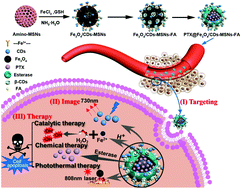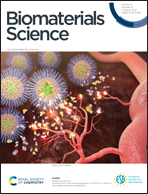The facile formation of hierarchical mesoporous silica nanocarriers for tumor-selective multimodal theranostics †
Abstract
The combination of therapeutic and diagnostic functions in a single platform has aroused great interest due to the more optimal synergistic effects that can be obtained as compared to any single theranostic approach alone. However, current nanotheranostics are normally formed via complicated construction steps involving the pre-synthesis of each component and further conjugation via chemical bonds, which may cause low integration efficiency and limit production and applications. Herein, a tumor-targeting and tumor-responsive all-in-one nanoplatform based on mesoporous silica nanocarriers (MSNs) was fabricated via a facile approach utilizing efficient and nondestructive physical interactions for long-wavelength fluorescence imaging-guided synergistic chemo-catalytic-photothermal tumor therapy. The MSNs were endowed with these multimodal theranostics via a simple hydrothermal method after coordinating with Fe2+ and glutathione (GSH) to introduce ferroferric oxide and carbon dots in situ. The former acts as a photothermal agent and catalytic agent to generate local heat under 808 nm irradiation and also when toxic hydroxyl radicals (˙OH) are in contact with abundant hydrogen peroxide in cancer cells, while the latter participates in fluorescence imaging. After loading with paclitaxel (PTX), polyester and folic-acid-conjugated cyclodextrin were employed to serve as an esterase-sensitive gatekeeper controlling PTX release from the MSN pores and as a tumor-targeting agent for accurate therapy, respectively. As expected, the nanoplatform was efficiently taken up by tumor cells over healthy cells, and then, synergetic chemo-catalytic-photothermal therapy was performed, resulting in 5-fold greater apoptosis of tumor cells as compared to healthy cells under 808 nm irradiation. Moreover, in vivo data from tumor-bearing mouse models showed that tumors were significantly inhibited, and the survival rates of these mice increased to greater than 80% after 5 weeks of treatment with our nanoplatform. These therapeutic processes could be directly tracked via fluorescence imaging enabled by carbon dots and, therefore, our nanoplatform provides a promising theranostics approach for tumor treatment.



 Please wait while we load your content...
Please wait while we load your content...